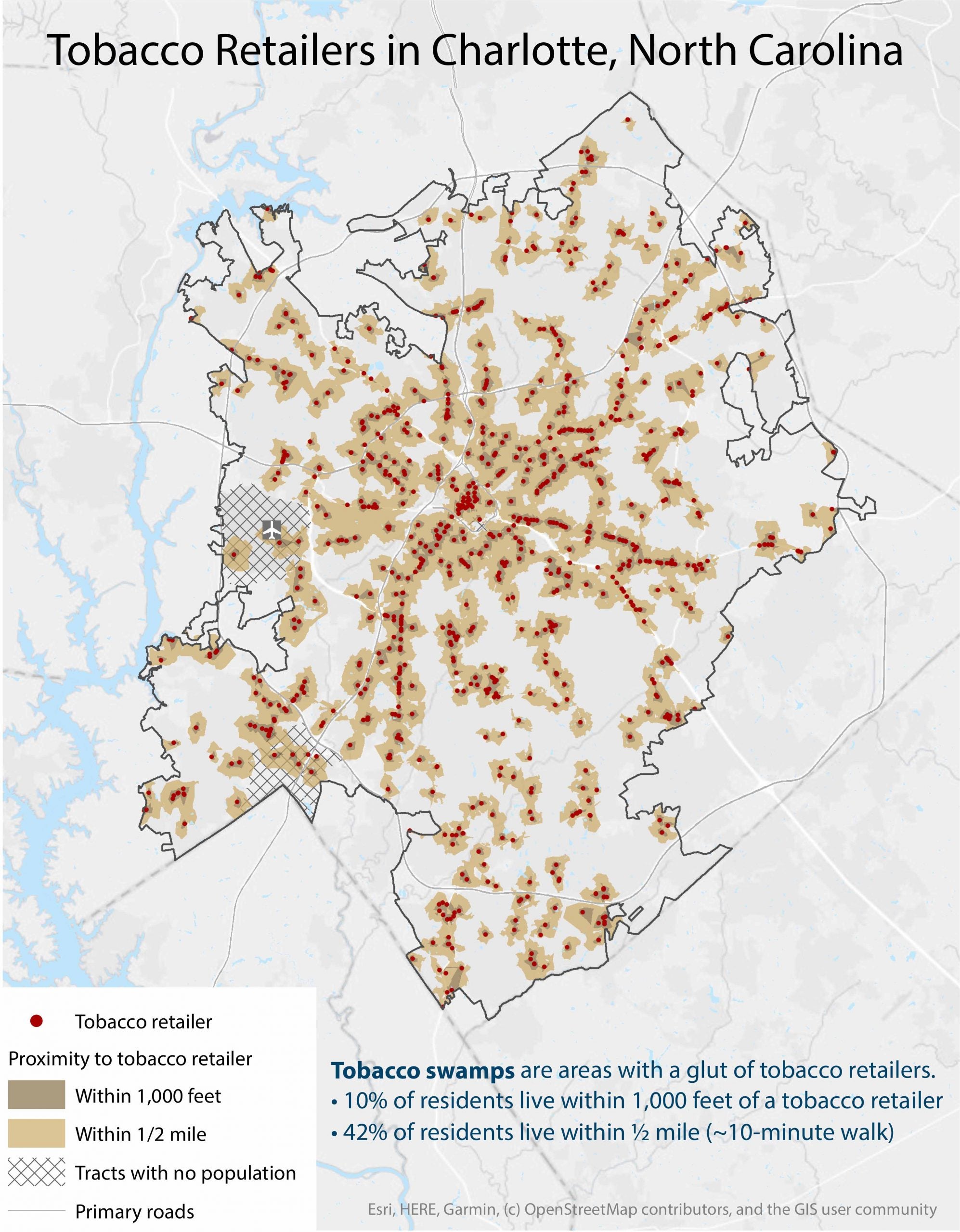Study: Public health could be improved by reducing ‘tobacco swamps’
A new study co-authored by an East Carolina University researcher finds that public health could be improved by reducing “tobacco swamps” — densely located stores that sell tobacco products.
Similar to “food swamps,” a term used to describe areas with a high density of restaurants or stores selling unhealthy food, the research concludes that living near more tobacco retailers is linked with people being more likely to use tobacco and less likely to quit.

Charlotte has 1,032 tobacco retailers, and 43.1% of public schools are within 1,000 feet of a tobacco retailer. (Contributed graphic)
The analysis, published earlier this month in the international journal Tobacco Control, examined and statistically combined the results of 27 studies of tobacco retail density, adult tobacco use, and health outcomes from eight countries: Australia, Canada, Denmark, England, Finland, New Zealand, Scotland and the United States.
In the U.S., there are 27 brick-and-mortar tobacco retailers for every one McDonald’s restaurant, equaling 375,000 tobacco retail locations. Retailers are not equally distributed and tend to be clustered in lower-income and minority communities, according to the study.
The researchers, including lead author Dr. Joseph G.L. Lee, associate professor of health education and promotion in the College of Health and Human Performance at ECU, found that lower tobacco retailer density was associated with a 2.6% reduction in the risk of tobacco use behaviors. The study also explored differences in results by gender, income level and intensity of tobacco use.
“Broadly speaking, implementing policies that reduce the number and concentration of stores selling tobacco could decrease smoking by between 2 and 3% among adults,” Lee said.
Senior author Dr. Lisa Henriksen, a principal investigator of the ASPiRE Center (Advancing Research and Practice in the Retail Environment) and senior research scientist at Stanford Prevention Research Center, said: “This paper strengthens the evidence that addressing the oversupply of tobacco products is an important strategy for preventing cancer and improving health.”
Tobacco use is the leading preventable cause of death in the U.S., with 480,000 deaths and more than $300 billion in health care spending and productivity losses caused by cigarette smoking each year, according to ASPiRE Center data.
Tobacco retail stores are heavily concentrated in certain areas, particularly in low-income neighborhoods. “We know higher retail density is associated with increased tobacco product use and higher rates of youth initiation,” said Dr. Kurt Ribisl, a principal investigator of the ASPiRE Center and Jo Ann Earp Distinguished Professor at the Gillings School of Global Public Health at the University of North Carolina at Chapel Hill.
Lee and faculty members from UNC, Washington University in St. Louis and Stanford University School of Medicine are members of the ASPiRE Center, a research collaborative funded by the National Institutes of Health. The center is working to build a scientific evidence base for effective policies in the retail environment to help reduce tobacco use, tobacco-related disparities, and the public health burden of tobacco, including cancer.
The researchers investigate how retail reduction strategies and other innovative tobacco interventions impact people and communities. The center works to counteract the nearly $1 million per hour the tobacco industry spends promoting its products.
(Laura Brossart of the Brown School Center for Public Health Systems Science at Washington University contributed to this story).
Related:
https://news.ecu.edu/2019/06/05/design-matters/
https://news.ecu.edu/2019/09/26/vaping-phenomenon/
https://news.ecu.edu/2018/09/04/teens-and-tobacco/